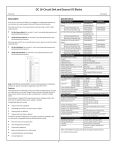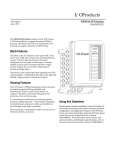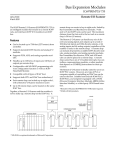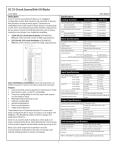Download 16-Circuit DC Sink/Source Blocks IC660BBD020,021,022,023, GFK
Transcript
DC 16-Circuit Sink and Source I/O Blocks March 2010 GFK-0043H Description Specifications Catalog Numbers Block type 24/48 VDC 16 Circuit Source I/O Block Terminal Assembly only Electronics Assembly only 24 VDC 16 Circuit Source I/O Block Terminal Assembly only Electronics Assembly only 24/48 VDC 16 Circuit Sink I/O Block Terminal Assembly only Electronics Assembly only 24 VDC 16 Circuit Sink I/O Block Terminal Assembly only Electronics Assembly only Block Specifications Size (height x width x depth) A DC 16-Circuit Source I/O Block is an intelligent, configurable module that can interface to a wide range of discrete DC sensors and actuators. There are two DC 16-circuit source blocks, which provide current to field output devices: ▪ ▪ 24 VDC Source Block, for use with 2- and 3-wire solid-state sensors and electromechanical sensors. 24/48 VDC Source Block, for use with 3-wire solid-state sensors and electromechanical sensors. There are also two DC 16-circuit sink blocks, which receive current from field output devices: ▪ ▪ 24 VDC Sink Block, for use with 2- and 3-wire solid-state sensors and electromechanical sensors. 24/48 VDC Sink Block, for use with 3-wire solid-state sensors and electromechanical sensors. Features DC 16-Circuit Source/Sink I/O Blocks have 16 discrete circuits, each easily configured to be an input, tristate input, or output. Output circuits can be connected directly to input circuits without the use of other components or inversion of logic states. Control power is tapped off the input/output device voltages wired to the terminals. No separate block power supply is needed. Configurable features include: Output Pulse Test capability Selectable Input Filter Time from 10ms to 100ms Output powerup defaults Output Hold Last State or default The block’s advanced diagnostics can pinpoint causes of installation and run-time errors. Diagnostics features of these blocks include: ▪ ▪ ▪ ▪ ▪ ▪ 8.83” (22.44cm) x 3.56” (9.05cm) x 4.42” (11.23cm) 4 lbs. (1.8 kg) Unit OK, I/O Enabled Individual load side indicators 1500V 68.8 Watts with 16 outputs on at 2 Amps. 18-56 VDC (24/48 V), 18-30 VDC (24 V) 10% 150mA typical, 300mA maximum 10ms Weight LEDs (I/O Block) LEDs (each circuit) Block to block Isolation Heat Dissipation Operating voltage Ripple (maximum) Required DC power Power supply dropout time Input Specifications For standard input, voltage relative to DCInput ON 24 VDC supply Source: 16-24 VDC Sink: 0-8 VDC 48 VDC supply* Source: 32-48 VDC Sink: 0-16 VDC* Input OFF 24 VDC supply Source: 0-7 VDC Sink: 17-24 VDC 48 VDC supply* Source: 0-14 VDC Sink: 34-48 VDC* Input impedance (typical) 5.6K Ohms (24/48V), 1.8K Ohms (24V) Input processing time (typical) 1.7ms (plus selectable filter delay) Selectable input filter times 5-100ms Input diagnostics Open Wire, Overtemperature, Failed Switch Output Specifications Output current (steady state) 2 Amps per circuit Maximum inrush current 10 Amps up to 10ms Block output current 12 Amps at 60°C at 30VDC 15 Amps at 35°C at 56VDC Output OFF leakage current 1.0 mA Maximum switching frequency Once per second (high inrush current) Output turn-on delay (maximum) 1ms Output voltage drop 2.0 volts maximum at 2 Amps inrush Minimum Recommended Load 50 mA with No Load enabled Output Diagnostics Short Circuit, Overload, No Load, Failed Switch, Overtemperature Environmental Specifications Operating Temperature -0° to +60°C (32° to +140°F) Storage Temperature -40 °C to 100 °C(-40° to +212°F) Humidity 5% to 95% (non-condensing) Vibration 5-10 Hz 0.012” displacement, 10-200 Hz at 1G 24/48 VDC Source In/Out ▪ ▪ ▪ ▪ 16 circuit discrete input and output IC66*BBD020, 6240BP10811DIC66*TSD020 IC66*EBD020 (same as block BBD022) IC66*BBD022, 6240BP10411DIC66*TSD022 IC66*EBD020 (same as block BBD020) IC66*BBD021 IC66*TSD021 IC66*EBD021 (same as block BBD023) IC66*BBD023 IC66*TSD023 IC66*EBD021 (same as block BBD021) Electronic short circuit protection Overtemperature protection Failed switch detection Open wire detection for tristate inputs Overload detection and shutdown Refer to GFK-0867 for product standards and general specifications. * for 24/48 VDC blocks No-load detection 1 DC 16-Circuit Sink and Source I/O Blocks March 2010 GFK-0043H Using this Datasheet This datasheet summarizes information about block installation, configuration, and diagnostics. Your primary reference should be the Discrete and Analog Blocks User’s Manual. It includes detailed instructions for block installation and configuration. For additional information about systems and communications, including bus specifications, refer to the I/O System and Communications Manual. For details about GMR, please refer to the GMR User’s Manual. Changes for this Release This release includes the module updates listed below. No field upgrade kit is available. Catalog Number Current Revision Revisions Affected TÜV Approved Block Type IC660BBD020 W, X Yes Source IC660EBD020 W, X Yes IC660BBD022 V, W, X No IC660BXD022 V, X No IC660BBD020CA W, X Yes IC660EBD020CA W, X Yes IC660BBD022CA W, X No IC660BBD022VCA1 N/A No IC661BBD020 V, X No IC661BBD022 V, X No 6240BP10811D V, X No 6240BP10821D V, X No 6240BP10411D V, X No V, X No W Yes Yes Catalog Number New Revision TÜV Approved Block Type IC660BBD020 X Y Yes 6240BP10421D IC660EBD020 X Y Yes IC660BBD021 IC660BBD022 X Y No IC660EBD021 W IC660BXD022 X Y No IC660BBD023 W No IC660BBD020CA X Y Yes IC660BBD021CA W Yes IC660BBD023CA W No IC660EBD020CA X Y Yes IC660BBD022CA X Y No IC661BBD020 X Y No IC661BBD022 X Y No 6240BP10811D X Y No 6240BP10821D X Y No 6240BP10411D X Y No 6240BP10421D X Y No IC660BBD021 W X Yes Yes IC660EBD021 W X IC660BBD023 W X No IC660BBD021CA W X Yes IC660BBD023CA W X No Source Sink These blocks are backward-compatible with previous block versions of the same type. However, their Terminal Assemblies are not backward compatible. The Electronics Assembly can be used to replace an earlier Electronics Assembly of the same type. The Terminal Assemblies of these blocks are not compatible with some earlier versions of the Electronics Assemblies. Block Type Sink Problems Resolved for this Release This release replaces all previous versions of these products. There are no compatibility issues with older block versions. In the product revisions listed in the following table, output pulse tests may not generate No Load faults for even-numbered output circuits as expected, when they are operated either without loads, or with load currents that are less than 50mA (50mA is the minimum required to avoid a No Load fault). No Load faults are reported for all output circuits, when appropriate, when the output is turned on by either the application or a Genius Hand-held Monitor. Terminal Assembly Not Compatible with Electronics Assemblies 24/48 VDC Source Block (IC66*BBD020, 6240BP10811D) IC66*TSD020 (version C or later) IC66*ELD020 any version IC66*EBD020 versions A to E 24 VDC Source Block (IC66*BBD022, 6240BP10411D) IC66*TBD022 (version B or later) IC66*ELD020 any version IC66*EBD020 versions A to E 24/48 VDC Sink Block (IC66*BBD021) IC66*TSD021 (version B or later) IC66*ELD021 any version IC66*EBD021 versions A to D 24 VDC Sink Block (IC66*BBD023) IC66*TBD023 (version B or later) IC66*ELD021 any version IC66*EBD021 versions A to D If the Terminal Assembly will be used to replace an earlier Terminal Assembly, and the Electronics Assembly is one of the incompatible versions listed above, the Electronics Assembly can be upgraded to make it compatible. The pulse test generates No Load faults for all output circuits, when appropriate, in the new revisions of these products listed above. Any Hand-held Monitor can be used with these blocks. HHM version IC66*HHM501 is required to change baud rate configuration or to configure the block for redundancy. Compatibility For an IC697 series PLC, the CPU and programming software must be version 2.0 or later. The bus controller must be IC697BEM731C or later. The issue resolved by this release affects the source/sink block versions listed in the next table. Customers with an affected hardware version who experience this issue may upgrade to the new block versions listed above. Alternatively, they may use the No Load fault indications that are generated, as appropriate, when an output is turned on, by the application or by a Genius Hand-held Monitor. For an IC600 series PLC, the CPU must be rev. 105 or later. For an IC600 series Plus PLC, rev. 110 or later is required. The programming software must be rel. 4.02 or later. If the bus controller is model IC66*CBB900, it must be version C or later. For an IC550 series PLC, the CPU must be rev. 3.0 or later. The programming software must be rel. 2.01 or later. All other versions of the source/sink blocks are unaffected by the issue described above. For an IC550 series PLC, the CPU must be rev. 3.0 or later. The programming software must be rel. 2.01 or later. 2 DC 16-Circuit Sink and Source I/O Blocks March 2010 GFK-0043H Block Operation Note that in GMR applications, Failed Switch operates differently. See the GMR User’s Manual for details. Each circuit can be configured as an input, a tristate input, or an output. If the block is configured as a combination block, output feedback is provided via the corresponding input references. Open Wire Diagnostic (standard) Indicates electrical (not mechanical) malfunctions on a tristate input. The circuit must have a non-inductive resistor placed as close as practical to the actual dry contacts (such as across the field device terminals), as shown previously. 16 Circuit DC Source I/O Blocks Overload Diagnostic (configurable) If Overload Shutdown is enabled, the block will turn the output off and send an OVERLOAD message if a load exceeds 2.8 Amps DC continuously for 10ms. currents. Exceeding these limits may cause an overtemperature fault. A DC source block has all output devices connected to the negative (-) side of the power supply. Inputs control the positive (+) side. DC+ Configured as an Input DC+ Input Device Smart Switch I/O 1 - 16 Configured as an Output Output Device * .1µfd LED DC- Field Connections A load that requires more than 2 Amps DC can be configured not to shut off at this level or send the OVERLOAD message. 75V Terminal Assembly 1200 Ohms DC- Electronics Assembly * No Load Diagnostic (configurable) If a load does not continuously draw 50mA from the output circuit, the block sends a NO LOAD message. A No Load condition may cause an HHM monitoring the block to display 0 for the circuit although there is voltage at the output and the circuit LED is on. This diagnostic should be not be used for circuits on which very small loads (small relays, transformers, or indicating lamps) will draw less than 50 mA. Processor Note that in GMR applications, No Load operates differently. See the GMR User’s Manual for details. 5.6K Ohms for 24/48 VDC Blocks 1.8 Ohms for 24 VDC Blocks Operating Note 16 Circuit DC Sink I/O Blocks A DC sink block has all output devices connected to the positive (+) side of the power supply. Inputs control the negative (-) side. When a Genius Hand-held Monitor is used to initiate an output pulse test, it may display a PULSE TEST FAILED message after the test completes. A Pulse Test COMREQ may return Status Code 2048 “Device did not accept the message, or timed out.” DC+ DC+ .1µfd Configured as an Output This occurs more frequently when the output points have No Load fault reporting enabled and some, or all, of the output points physically have no load, or are operated with load currents less than 50mA. (50mA is the minimum required to avoid a “No Load” fault.) If this issue occurs, repeat the output pulse test command. 1200 Ohms Output Device I/O 1 - 16 Configured as an Input LED * Smart Switch Input Device Field DC- Connections 75V Processor Configuration DCTerminal Assembly * Each block must be configured with a Hand-held Monitor to: Electronics Assembly ▪ ▪ 5.6K Ohms for 24/48 VDC Blocks 1.8 Ohms for 24 VDC Blocks Enter its Device Number (serial bus address). Enter its Reference Number (required only for IC600 and IC550 series PLCs only). In addition, unless all circuits on the block will be inputs, the Block I/O Type must be set to either Outputs or Combination on the Program Block ID screen. Diagnostics The block always performs its standard diagnostic checks, plus two configurable output diagnostics. The block reports all faults to the Handheld Monitor, and takes appropriate corrective action. Note: If a block is configured offline, it must be properly grounded and have a 75 Ohm resistor installed across its Serial 1 and Serial 2 terminals. See the Discrete and Analog I/O Blocks User’s Manual for instructions. Short Circuit Diagnostic (standard) If the instantaneous current exceeds 10 Amps at turn-on, the block turns the output off. The block attempts to restart the load; if two attempts are unsuccessful, the output circuit is forced off and the block sends a SHORT CIRCUIT message. The cause of the current surge must be removed, then the diagnostic must be cleared from the HHM or the CPU. Overtemperature Diagnostic (standard) If the block’s internal temperature exceeds 120º C, the block sends an OVERTEMPERATURE message and turns off the circuit to protect its internal electronics. Failed Switch Diagnostic (standard) For an output, Failed Switch is reported if the circuit’s switch state is not the same as its commanded state. The block sends a FAILED SWITCH message identifying the failed circuit. The logic state of the circuit is set to OFF. If the output switch has failed shorted (or closed), current flow is not interrupted when the block forces the output state OFF. Action external to the block must be taken to remedy the problem. Several additional switch faults independent of the output state are detected and reported as Failed Switch faults on both input and output-configured circuits. Examples include loss of communications with the block’s internal microprocessor and some internal power supply faults. 3 DC 16-Circuit Sink and Source I/O Blocks March 2010 GFK-0043H The rest of the features can be configured either using a Hand-held Monitor, or by sending a Write Configuration datagram to the block from the host. Feature Circuit or Block Factory Setting Block Mounting Genius I/O blocks are considered "open equipment" and therefore must be installed within a protective enclosure. They should be located in an area that is clean and free of airborne contaminants. There should be adequate cooling airflow. Selections Baud Rate B 153.6 std 153.6 std, 153.6 ext, 76.8, 38.4 Block I/O Type B input input, output, combination Pulse Test B enabled enabled, disabled Input Filter Time B 20ms 5-100ms Circuit I/O Type C input input, output, tristate input Report Faults C yes yes, no Hold Last State C no yes, no Output Default State C off on, off Detect No Load C yes yes, no Overload Shutdown C yes yes, no BSM Present B no yes, no Output Timeout B 3 bus scans 2.5, 10 seconds none, standby, duplex, GMR Redundancy Mode B none Duplex Default B off on, off Config. Protect B disabled enabled, disabled The block can be mounted right side up, or upside down. Leave at least 2 inches of space between blocks. Mount the block by drilling two screw or bolt holes for 8-32 hardware. Position the block so that the notches in the upper and lower flanges line up with the mounting holes. Mount the block using 8-32 screws. Use star washers to provide ground integrity. Grounding The block’s mounting screws must not be used as the only means of grounding the block. Connect the green ground screw on the block to a reliable ground system using a short wire lead, minimum size AWG #12 (avg 3.3mm2 in cross-section). Warning If mounting screws do not make good ground connection and the ground screw is not connected to a reliable ground, the block is not grounded. Electrical shock hazard exists. Death or personal injury may result. Removing an Electronics Assembly The block’s Electronics Assembly can be replaced with a compatible model without removing field wiring or reconfiguring the block. If you are replacing an older Electronics Assembly, first read the instructions at right. Configuration Note for 24/48VDC Sink and Source Blocks in GMR Systems This note applies only to the 24/48VDC blocks (for example: IC66*BBD020M or later and IC66*BBD021M or later) when they are used in configured Input Groups in a GMR system. GMR (Genius Modular Redundancy) is a specific type of application requiring the use of GMR configuration and program software tools. Electronics Assembly Retaining Screws (Qty. 2) If Input Autotesting for the Input Group is turned ON in the GMR Configuration, then during the Genius configuration of the blocks in the group, the Output Pulse Test feature must be disabled. Otherwise, circuits that would normally pass the Input Autotest are incorrectly reported as having failed. When Output Autotest is disabled, the Input Autotest feature functions correctly. Terminal Assembly Connector Pins Installation Instructions Carefully inspect all shipping containers for damage. If any equipment is damaged, notify the delivery service immediately. Save the damaged shipping container for inspection by the delivery service. After unpacking the equipment, record all serial numbers. Save the shipping containers and packing material in case it is necessary to transport or ship any part of the system. 1. Unscrew the retaining screws at the top and bottom of the block. 2. Using a Block Puller (IC660BLM507), engage the tabs in the first vent slots. Move the tool to the center of the block and squeeze the handle. Pull the Electronics Assembly upward. 3. Installation in Hazardous Locations Warning The following information is for products bearing the UL marking for Hazardous Locations: • • • • If power is applied to the field terminals, power is also exposed on the connector pins at the base of the Terminal Assembly, and electrical shock hazard exists. Do not touch the connector pins! Death or injury may result. THIS EQUIPMENT IS SUITABLE FOR USE IN CLASS I, DIVISION 2, GROUPS A, B, C, D OR NON-HAZARDOUS LOCATIONS ONLY. WARNING - EXPLOSION HAZARD - SUBSTITUTION OF COMPONENTS MAY IMPAIR SUITABILITY FOR CLASS I, DIVISION 2; WARNING - EXPLOSION HAZARD - WHEN IN HAZARDOUS LOCATIONS, TURN OFF POWER BEFORE REPLACING OR WIRING MODULES; AND WARNING - EXPLOSION HAZARD - DO NOT DISCONNECT EQUIPMENT UNLESS POWER HAS BEEN SWITCHED OFF OR THE AREA IS KNOWN TO BE NONHAZARDOUS. Inserting an Electronics Assembly 1. Align the Electronics Assembly in the guides and push down firmly. Caution 2. 4 Do not exert excessive force; it may damage the block. If unusual resistance is met, remove the Electronics Assembly. If power is applied to the block, DO NOT TOUCH THE CONNECTOR PINS! Inspect the Terminal Assembly, connector receptacle, and connector edge board (on the Electronics Assembly). Be sure the DC 16-Circuit Sink and Source I/O Blocks March 2010 GFK-0043H keying matches. Remove any obstacles and reinsert the Electronics Assembly. Pay close attention to the alignment of the guide pins. Start of Bus Terminating Resistor Terminating Resistor Note: Before hot inserting an Electronics Assembly, be sure that all connector pins are straight and that the Electronics Assembly is lined up squarely with the Terminal Assembly. Failure to insert the Electronics Assembly so that all pins mate simultaneously may result in the block not powering up correctly, or being repeatedly added and lost by its bus controller. 3. End of Bus Serial 1 Serial 2 Shield In Shield Out Serial 1 Serial 2 Shield In Shield Out Wiring for a Bus Switching Module Secure the Electronics Assembly with the screws on the top and bottom of the Terminal Assembly. If the block will be a BSM Controller, attach the Bus Switching Module to the block’s serial bus terminals. Attach the serial bus cables to the BSM as described in the Bus Switching Module datasheet. Wire the BSM like a load to circuit 1. Connect either BSM pigtail wire to terminal 6. Connect the other BSM wire to DC-. Replacing an Older Electronics Assembly If the Electronics Assembly (IC66*EBD020 or EBD021) will replace Electronics Assembly model IC66*ELD020, or ELD021 (only), follow the steps below. Otherwise, some inputs may operate incorrectly. Power Connections 1. Before removing the old Electronics Assembly from the Terminal Assembly, connect a Hand-held Monitor to the block. 2. If there is any other HHM currently connected anywhere on the bus, it must be disconnected, not just turned off. Connect a DC power source to the DC+ terminal (5) and the return to the DC- terminal (22). Depending on the layout and current loads, positive and negative connections can be bussed and made by individual wires back to the block or power source. 3. Power up the HHM and proceed to the Block/Bus Status menu. Select the block as the “active” block on the HHM. Connections for a DC Source Block 4. Proceed to the MNTR/CTRL REF menu. Then: 5. a. Monitor one of the first eight circuits on the block (for example, circuit #1). Press the RELEAS key. b. Monitor one of the second eight circuits on the block (for example, circuit #90. Press RELEAS. Any circuit can be an input or output. Connect one terminal of the device to the block (terminals 6-21). Connect outputs to DC- and inputs to DC+. Connect outputs to the negative side of the power supply and inputs to the positive side. No logic inversion is needed. 5 Press the Hand-held Monitor OFF key and disconnect the HHM from the block. DC+ 6 1 6. Power down the block. Remove the Electronics Assembly. 7 2 7. Insert the new Electronics Assembly. Power up the block. 8 3 9 4 10 5 11 6 12 7 13 8 14 9 If the new Electronics Assembly was installed without following these steps and the block is powered up, inputs may be operating incorrectly. Connect a Hand-held Monitor and follow the procedure described above. Block Wiring 2 All terminals accept one AWG #12 wire (avg 3.3mm cross-section) or two AWG #14 wires (each avg 2.1mm2 in cross-section). The minimum recommended wire size is AWG #22 (avg .36mm2 in cross-section). FIELD INPUT DEVICES FIELD OUTPUT DEVICES 15 10 LOAD 16 11 Block terminals can also accommodate spade or ring terminals up to 0.27 inch (6.85mm) wide with a minimum opening for a #6 screw, and up to 0.20 inch (5.1mm) depth from the screw center to the back barrier. Be sure unshielded wire ends are not longer than 2 inches (5 cm). DC+ DC- 17 12 LOAD 18 13 19 14 Do not overtorque the terminal screws. Recommended torque for all terminals is 6 in/lb (.678 N/M). 20 15 Serial Bus Wiring 22 LOAD 21 16 Using one of the cable types recommended in the System and Communications User’s Manual, connect the serial bus to terminals 1- 4. (If a Bus Switching Module will be connected directly to the block, see below instead). LOAD DC- DC Source Block, Wiring for Tristate Inputs If any input is configured as a Tristate Input, install a resistor across the dry contacts of the input device. This added resistance is required to use the Open Wire diagnostic. The LED will glow dimly as a result. + 1 SERIAL 1 2 SERIAL 2 3 SHIELD IN 4 SHIELD OUT IN - If the block is at either end of the bus, connect a terminating resistor of the appropriate type (see the System and Communications User’s Manual for details) across its Serial 1 and Serial 2 terminals. For a 24/48 VDC block, the resistor be 5.1K Ohms, 1/2 Watt or larger. For a 24 VDC block, it should be 1.6K Ohms. 5 DC 16-Circuit Sink and Source I/O Blocks March 2010 GFK-0043H DC Source Block, Power Disconnects DC Sink Block, Power Disconnects It is important to wire block power disconnects so that block power and input power will be removed at the same time. Locate the power disconnect as shown below. YES It is important to wire block power disconnects so that block power and input power will be removed at the same time. Locate the power disconnect as shown below. DC SOURCE BLOCK NO DC SINK BLOCK DC+ DC+ LOAD LOAD DC- DCYES Caution Caution If circuit power is not removed at the same time as block power, the block may power up when multiple inputs are activated, even though one leg of power has been removed from the block. If circuit power is not removed at the same time as block power, the block may power up when multiple inputs are activated, even though one leg of power has been removed from the block. Connections for a DC Sink Block Any circuit can be an input or output. Connect one terminal of the device to the block (terminals 6-21). Connect outputs to DC+ and inputs to DC. FIELD INPUT DEVICES Block LEDs The block's Unit OK and I/O Enabled LEDs show its operating status: Unit OK DC+ 5 6 1 7 2 8 3 9 4 10 5 11 6 12 7 13 8 14 9 15 10 LOAD DC- 17 12 LOAD 18 13 19 14 LOAD 20 15 21 16 22 LOAD DC- I/O Enabled Meaning ON ON Block functioning, CPU communicating ON OFF Block functioning, No CPU communications for 3 bus scans ON Blinking Block functioning, Circuit forced Blinking ON Circuit fault, CPU communicating Blinking OFF Circuit fault, No CPU communications for 3 bus scans Alternate Blinking Circuit fault, Circuit forced Synchronous Blinking No CPU communications - block number conflict OFF No block power, or block faulty OFF Each circuit has its own LED. If the circuit is configured as an input, the LED indicates the presence of threshold voltage at the input terminal. If the circuit is configured as an output, the LED indicates the actual state of the load. 16 11 DC+ NO FIELD OUTPUT DEVICES DC Sink Block, Wiring for Tristate Inputs If any input is configured as a Tristate Input, install a resistor across the dry contacts of the input device. This added resistance is required to use the Open Wire diagnostic. The LED will glow dimly as a result. + IN - For a 24/48 VDC block, the resistor be 5.1K Ohms, 1/2 Watt or larger. For a 24 VDC block, it should be 1.6K Ohms. 6
















